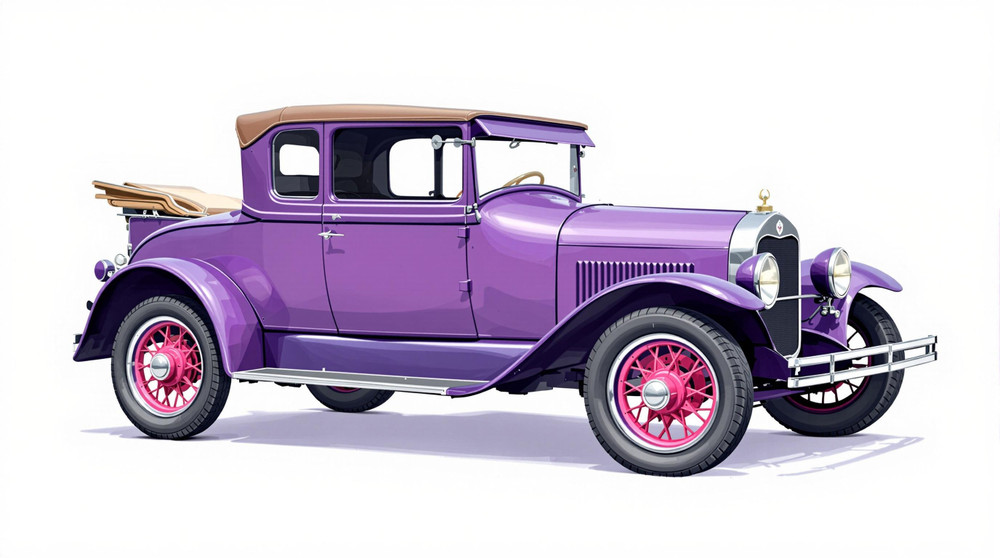Image of 1919 Dodge Model 30, Note: These illustrations use artistic license and may differ from actual historical models.
Performance Metrics
Fundamental Metrics
Emotional Appeal
MMP Rating
| Engine Specifications | |
|---|---|
| Engine: | Inline-4 |
| Displacement: | 212 cubic inches |
| Horsepower: | Estimated 35 HP |
| Torque: | Not available |
| Compression Ratio: | Not available |
| Ignition System: | Magneto |
| Cooling System: | Water-cooled |
| Performance Specifications | |
| 0-60 Time: | Not available |
| 1/4 Mile Time: | Not available |
| Top Speed: | 50 mph |
| Transmission and Drive | |
| Drive Type: | Rear-wheel drive |
| Transmission Type: | 3-speed manual |
| Fuel and Efficiency | |
| Fuel System Type: | Carburetor |
| MPG: | Not available |
| Dimensions and Brakes | |
| Brakes: | Mechanical drum brakes |
| Wheelbase: | 114 inches |
| Weight: | 2,400 lbs |
Note: Specifications for classic cars are given to the best of our ability, considering the limited and variant data available.
A Journey Back to the Dawn of the Roaring Twenties: The 1919 Dodge Model 30
The 1919 Dodge Model 30 stands as a testament to the ingenuity and ambition that propelled the early automotive industry into a new era. Crafted by the Dodge Brothers, who were once key suppliers for Ford before venturing out on their own, this vehicle emerged from an era of industrial optimism and technological progress. The Model 30 was not just a car; it was a symbol of post-World War I America, a nation ready to drive full-throttle into modernity. One might be surprised to learn that despite its age, the Model 30 was among the first to introduce an all-steel body in passenger cars, setting a new standard in automotive construction.
Design and Innovation: A Glimpse of Early Automotive Artistry
The exterior of the 1919 Dodge Model 30 exuded a charm that was both stately and functional. With its tall, upright grille and rounded fenders, it presented an authoritative silhouette that commanded respect on the burgeoning roadways of America. Inside, passengers were greeted with a cabin that prioritized simplicity and durability over luxury. Materials were chosen for their longevity, with heavy-duty fabrics and robust leathers being common choices. Technologically, the Model 30 was ahead of its time. It featured a 12-volt electrical system at a time when 6-volt systems were standard—a forward-thinking addition that improved starting reliability and lighting. Color options were limited compared to today's standards, but popular hues included deep blues and blacks that added to the car's dignified appearance. Body styles varied, with the touring version being particularly popular for its open-air experience, allowing drivers and passengers alike to enjoy their travels with a sense of freedom that was novel at the time.
Historical Significance: Paving the Way for Modern Motoring
The Dodge Model 30's impact on automotive design cannot be overstated. It was one of the pioneers in using an all-steel body construction, which not only improved safety but also paved the way for more streamlined manufacturing processes. This innovation marked a departure from wood-framed vehicles and helped set new standards for durability and production efficiency. What truly set this car apart from its contemporaries was its reputation for reliability and value. It offered features such as electric starters and lights—luxuries at the time—that would soon become industry standards.
Performance and Handling: A Reflection of Its Time
Performance-wise, the Model 30's four-cylinder engine delivered modest power, allowing it to reach top speeds that would seem leisurely by today's standards but were quite respectable in its day. Acceleration was unhurried yet steady, embodying the era's pace of life. Handling reflected the technology of the time with solid axles and leaf springs offering a ride that could handle unpaved roads but might challenge modern sensibilities used to smooth suspensions. Driving a Model 30 was an immersive experience—the rumble of its engine, the tactile feedback through its thin steering wheel, and the distinctive scent of oil and gasoline creating an unmistakable ambiance.
Ownership Experience: A Nostalgic Endeavor
In its heyday, the Dodge Model 30 served various roles—from daily transportation to leisurely Sunday drives. Today, maintaining such a classic requires dedication; parts can be scarce, and knowledge of vintage car mechanics is essential. However, for enthusiasts, this is part of its charm. Despite potential challenges in sourcing parts or expertise for repairs, many vintage car clubs and communities offer support to owners looking to preserve these pieces of history.
Fun Facts: The Dodge Model 30 Through Time
The Dodge Model 30 has had its share of unique trivia throughout history. While records about rare editions or celebrity ownerships may be obscured by time, it's known that Dodge vehicles were favored by law enforcement agencies in the early days due to their robust construction. While not known for breaking speed records, it did set sales records for Dodge at the time and contributed significantly to establishing Dodge as a major player in the automotive industry.
Collector's Information: A Vintage Gem
As for rarity and market availability, precise production numbers for vehicles from this era are often hard to come by. However, it is estimated that tens of thousands of these vehicles were produced. As with many vehicles from this period, survival rates are low due to their age and susceptibility to rust. For collectors today, finding a 1919 Dodge Model 30 can be akin to uncovering treasure. Prices can vary widely based on condition but expect figures well into five digits for well-maintained or restored examples. As interest in pre-war classics remains steady among collectors, values may appreciate over time.
Conclusion: Celebrating Automotive Heritage
The 1919 Dodge Model 30 is more than just an antique; it's a rolling piece of history that offers us insight into an era when automobiles began shaping modern society. Its legacy lies not only in its engineering feats but also in its embodiment of American resilience and innovation during a transformative period. For those fortunate enough to witness or own one today, it represents a journey back in time—a testament to where we've been and how far we've come.
1919 Dodge Model 30 Catalog of Parts
 1919 Dodge Model 30 Step Plate Pad. Rubber face only. 4-1/4" O.D. Each-SP 18Step Plate Pad. Rubber face only. 4-1/4" O.D. Each
1919 Dodge Model 30 Step Plate Pad. Rubber face only. 4-1/4" O.D. Each-SP 18Step Plate Pad. Rubber face only. 4-1/4" O.D. EachWhy Choose Metro?
For over 100 years, Metro Moulded Parts has been the pinnacle of quality in classic car restoration parts. Our commitment to precision and authenticity in every component ensures a perfect fit and an OEM-level appearance.
- Expert Craftsmanship & Quality: Each part is a testament to our dedication to reliability and perfection, crafted from original designs and thoroughly tested.
- Advanced Technology: We use cutting-edge techniques to create flawless, long-lasting parts that surpass others in performance.
- SuperSoft Sponge – The Ultimate Door Seal: Not only are our door seals 30% softer than competitors', but they're also guaranteed to never leak. They effectively reduce wind and road noise, enhancing your classic car's comfort and driving experience.
- Proudly American: Our parts are a product of American craftsmanship, made in the USA with a spirit of excellence and heritage.
- Unrivaled Warranty: We back our products with a 30-year industry-leading warranty, a testament to our confidence in their quality.
Join us in preserving the legacy of classic cars with parts that are crafted for perfection, not just made.

